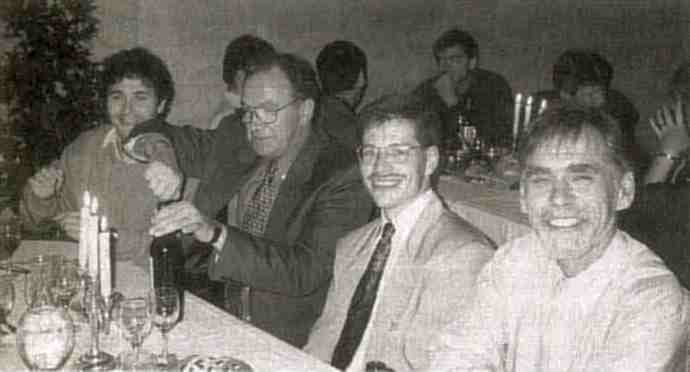


Meeting report
Thirty Years of Sagamore Conferences
 Wining ... Pierre Becker tackling an experimental problem close to his heart at the Sagamore Conference Dinner. (Courtesy of B. Forsyth)
Wining ... Pierre Becker tackling an experimental problem close to his heart at the Sagamore Conference Dinner. (Courtesy of B. Forsyth)
The XV Sagamore Conference on Charge, Spin and Momentum Density, a meeting dedicated to cross fertilization in these areas, was held in Brittany, August 7-12, 1994. The first Sagamore Conference (1964), the brain child of R. J. Weiss, took its name from its venue, a country estate originally owned by the Vanderbilt family of railway fame. Dick Weiss managed to persuade the US Army Materials Research Agency to support the first meeting, though he was later to admit that "the possibility that US Army tank specifications in the year 2064 would require that its wavefunctions be specified to within 1% at all points in the atomic polyhedra" had little to do with the sponsorship. Sagamore I was a tribute to the interest of the Watertown group (R. Beeuwkes Jr., D. Chipman, J. DeMarco, L. D. Jennings, K. Tauer, and Weiss) in the calculation of charge and spin density and its measurement by precise X-ray and neutron diffraction techniques.
By Sagamore III in Vanois National Park, France (1970), momentum density took a full share in the proceedings. An ad-interim Commission on Charge, Spin and Momentum Density was approved at the Kyoto Meeting of the IUCr in 1972 (D. Weiss, chairman). The Commission assisted N. N. Sirota to organize Sagamore IV in Minsk (1973) where Brunel and deBergevin reported their observation of a new effect, very weak magnetic scattering of X-rays. A cautious reporter wrote "whether such work will be more than a curiosity remains to be seen".
The IUCr Commission was established in 1975. The new Commission's first chairman and secretary were E. F. Bertaut and M. J. Cooper. Subsequent Sagamore Conferences took place in Finland, Canada, Japan, Sweden, Portugal and Germany.
The 1994 Conference was organized by G. Loupias, Laboratoire de Minéralogie-Cristallographie, U. Pierre & Marie Curie, Paris and S. Rabii, U. of Pennsylvania. Record attendance (180) demonstrated continuing vitality of both the science and the scientists. At least six of the latter had attended Sagamore I.
The Conference was opened by H. Curien, sometime Minister for Science in the French government, who spoke of the cooperation required for large scientific instruments throughout the world and stressed the difficulty of obtaining long term commitments to operational funding which would last beyond the local density approximation, with positron annihilation serving as an appetizer before lunch. The late afternoon session explored the application of maximum entropy methods to the reconstruction of charge and magnetization densities which lead into a panel discussion accompanied by spirited audience participation.
Monday was magnetic. After dinner, the Commission held an open meeting for reports on two of its current projects: Quantum Chemical Description of Electronic Structure from Experimental Charge and Momentum Densities (leaders W. Weyrich and V. Smith, Jr) and Fermiology of High-Tc Superconductors via High Resolution Synchrotron-Based Compton Scattering Spectroscopy (A. Bansil).
Tuesday was marred by bad weather, but the science did not suffer: molecular dynamics, pseudopotential calculations of ground state charge densities, multipolar analysis, the potential of the ESRF for charge studies using hard X-rays and spin density waves in organic conductors led naturally to an indoors picnic lunch. The afternoon excursion to the island of Ouissant took place even though the sea, which had been promised to be as flat as a maximum entropy prior, took on quite a different wavefunction and led to widespread reemergence of the picnic lunch. Those who visited the museum devoted to lighthouses and buoys learned of a different aspect of Fresnel's work and his crucial role in the development of France's coastal warning system.
Electrostatic potentials at the surface of molecules and crystals got Wednesday away to a good start: E. F. Bertaut showing how the latter could be calculated on the back of an envelope, or at least without a computer. Charge densities and excitations with X-ray dichroism led the field into lunch. The second excellent poster session was followed by a reception given in the Townhall by the Mayor of Brest, and a discussion of the Commission's project on Multipole Refinement and Properties (leader C. Lecomte) which included a report by T. Koritsanky, who leads the group which is receiving financial support from the IUCr for the development of a new multipole refinement package.
On Thursday, we heard about Compton scattering, including a contribution from high energy neutron scattering abour their extinction and thermal vibrations, how to calculate charge densities and their total energies, and about their topological properties. Visual stimulation efore the conference dinner in Kergroaes Castle was provided by the sight of Bretagne's largest menhir. By Friday, Fermiology had broken out, but Compton had the last word after an interjection of (e,2e) spectroscopy. D. Feil, Commission chairman, announced that Sagamore XII will be organized by B. Robertson in Saskatchewan, Canada in August 1997.
A workshop connected with the Fermiology Project will be held in Himeji, Japan at the site of SPRING-8 in July 1995.
Bruce ForsythSecretary, Commission on Charge, Spin and Momentum Density


